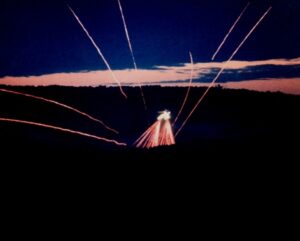All new Firebird wingman aircraft commanders (a/c) are assigned to fly supporting the fire team leader on all missions. The primary duty of the wingman is to always cover your lead. Fly any formation but be certain to cover your lead.
Its’ Spring 1969, I am the new Firebird “99” Aircraft Commander flying as a ‘wingman’. With Suber as (FTL) and my crew flying his wing we were on regular duty rotation stand-by at Landing Zone (LZ) Baldy supporting the 196th Light Infantry Brigade (LIB). Nights at Baldy were always the same – hot, humid, nothing to do. Boredom and darkness as many remember. The two Firebird ‘guns’ are parked in ‘L’ shaped revetments on the Baldy ramp area along with the night ‘flare-ship’ helicopter.
Nearby is the crew stand-by hooch, inside are the crew bunks, one bare light bulb hanging from the open rafters, an AM radio tuned to the lone Armed Forces Vietnam Network (AFVN) music station, a wood desk/table with the TA-312 ‘land line’ telephone connected to the 196th LIB Tactical Operations Center (TOC), and a wall map overlay of the 196th area of operations (AO). And dirt – lots & lots of dirt – lots of dirt.
Close to midnight, the phone rings it’s alarm – Suber answers. ‘Bad guys are coming through the wire on the north Baldy perimeter’ is the call from the TOC. As Suber receives the mission instructions the Firebird crews’ immediately race to the parked gunships, start the engines, and in minutes are airborne – armed for the night fire support mission.
In the air over Baldy Suber briefs his fire team via the discrete gunship radio frequency. We are to employ suppressing fire in the ridgeline opening on the north side of the LZ Baldy perimeter. The TOC has confirmed that ‘bad guys’ are now ‘in the wire’ and are overrunning the Baldy perimeter defenses. Suber briefs the flight and break from target pattern, receives the final clearance to ‘go hot,’ and we roll-in to engage the target.
Following and covering Suber through the darkened hilltops saddle on our first pass I confirmed the perimeter target is ‘danger close’ to our friendlies. Firing my first pair of rockets into the dark night sky, the rocket exhaust sparklers showered my gunship with exploding confetti.
Once the rockets leave their side tubes flying earthward toward the perimeter there is little control over them. My first shot was lucky but dangerously close to the perimeter boundary ‘wire.’ Call it Kentucky windage.
Too close to be shooting uncontrollable rockets so near the perimeter, I switch to rapid firing, six-barrel Gatling-type ‘mini-guns’ that deliver 6,000 rounds of 7.62 mm rounds per minute – a terrifying solid red line of tracers easily followed and precisely directed. My door gunners do the same with their M-60 machine guns firing a deadly 7.62 mm red tracer path toward the target with surgical precision.

Suber continues to engage the target with his rockets and door gunner’s M-60s. I follow him – my ‘mini-guns’ screaming and door guns streaming their red tracer line to the perimeter.
We fly several ‘hot’ passes over the darkened perimeter. When Suber releases his next pair of rockets I watch in stunned horror as they crossed and collided in mid-flight. The rockets ‘kissed’ in mid-flight, one rocket veering sharply to the left and downward – striking directly inside the Baldy perimeter.
As missions go, there is always the usual clamor and clatter of gunfire, confusion, and radio noise that accompanies every hot operation. At once the TOC screams over the FM (fox mike) radio channel to ‘cease fire – cease fire! Firebirds cease fire.’ Something had gone terribly wrong. As we are landing at the LZ Baldy standby area, Suber was told to call the TOC on the Firebirds standby shack land line.
After shutdown, the call with the TOC confirmed that two American soldiers were killed as a result of our night’s action. The soldiers had been standing outside atop their bunker watching the Firebird gun team carry out its fire support mission, mistakenly killed by the errant rocket.
The soldiers were victims of a mis-guided rocket that had careened off course and exploded near their bunker. In an instant, both had perished from Firebird “friendly fire.” After receiving the news, Jim walked outside. Alone. Several minutes later I ventured from the standby shack toward him – leaning against the helicopter, crying and sobbing over the dead American soldiers.
In the darkness, I saw tears stream down his face as he choked out his grief at being responsible for the deaths of the two American soldiers. We spoke for a few minutes, and to this day I can’t recall what was said – but I remember how deeply saddened and troubled Jim was as a result of our night’s actions. I immediately reported the incident to “Rattler” operations and was told to stand down and wait for a replacement crew.
Nothing more was heard of the incident. There was no investigation either formally or informally. No time off for R&R, we continued dealing daily death and destruction while dodging the enemy’s disagreement diplomacy. Jim later returned to the States, moved on in life, and passed away in 1976.
The two young American soldiers who died on duty that night were protecting fellow soldiers from a hostile enemy. How ironic to be in the wrong place at the wrong time, themselves unprotected, and killed by those charged to protect them. A not so Happy Mother’s Day, 1969.
(c) Copyright – 2023 Vic Bandini